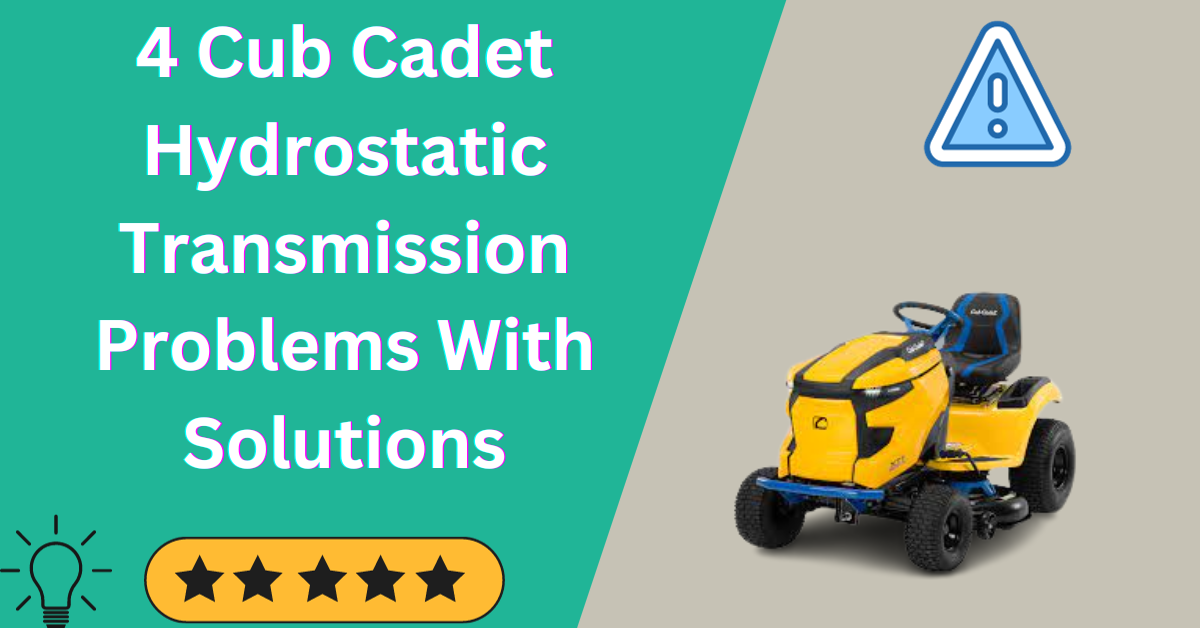Do you face hydrostatic transmission problems with your cub cadet? You are not alone. So in this article we will discuss the 4 most common cub cadet hydrostatic transmission problems with their easy solutions.
So if you encounter in these problems you can get solutions here. So read this article carefully if you want to get rid of these issues.
Some of the most common hydrostatic transmission problems of cub cadet are Loss of Power, Fluid Leaks, Erratic Movement and Noisy Operation.
Understanding Hydrostatic Transmissions
Before we delve into troubleshooting, it’s essential to understand how hydrostatic transmissions work. These systems use a hydraulic pump and motor to transfer power, offering smooth and variable speed control. However, they are not immune to problems.
Common Cub Cadet Hydrostatic Transmission Problems
Now we are going to discuss these problems one-by-one with their easy solutions. Note these problems are occurred in every model of cub cadet like 1045,1050,rxt 50 and it 1050.
1. Loss of Power
One common issue is a noticeable loss of power. Your Cub Cadet equipment may struggle to move or fail to reach its usual speed.
2. Fluid Leaks
Fluid leaks are another concern. If you notice puddles of hydraulic fluid beneath your machine, it’s a clear sign that something needs attention.
3. Erratic Movement
Sometimes, the equipment’s movement becomes erratic. It may lurch or fail to respond smoothly to your commands.
4. Noisy Operation
Unusual noises during operation, such as whining or grinding sounds, can also indicate transmission problems.
Troubleshooting Cub Cadet Hydrostatic Transmission Problems
Here are some troubleshoots if you encounter in these problems.
1. Check the Fluid Level
Begin your troubleshooting by checking the fluid level in the transmission reservoir. Low fluid levels can lead to poor performance.
2. Inspect for Leaks
Carefully inspect the transmission and hydraulic lines for any signs of leaks. Fixing leaks promptly can prevent further damage.
3. Adjust the Control Linkage
Proper control linkage adjustment ensures that the transmission responds accurately to your inputs.
4. Bleed the Air from the System
Air trapped in the hydraulic system can cause erratic behavior. Bleeding the system can help restore normal operation.
5. Inspect the Drive Belt
A worn or damaged drive belt can also lead to transmission problems. Inspect it for signs of wear and replace if necessary.
Preventive Maintenance Tips
Some maintenance tips to prevent from cub cadet 1045 hydrostatic transmission problems.
1. Regular Fluid Changes
Regularly changing the hydraulic fluid, typically recommended every 100 hours of use, can prolong the life of your transmission.
2. Keep the Cooling System Clean
A clean cooling system is essential for preventing overheating issues. Regularly clean any debris from the cooling fins and radiator.
3. Proper Storage
When storing your equipment for an extended period, ensure it’s in a dry and covered area. Proper storage can prevent many transmission problems.
Conclusion
Cub Cadet hydrostatic transmission problems are not uncommon, but with the right knowledge and maintenance, you can keep your equipment running smoothly. Regular fluid checks, leak inspections, and control adjustments can go a long way in preventing issues. Remember to address problems promptly to avoid further damage.
FAQs
How often should I check the hydraulic fluid level in my Cub Cadet equipment?
We recommend checking the fluid level every 25 hours of operation or as per your equipment’s manual.
Can I use any hydraulic fluid in my Cub Cadet hydrostatic transmission?
It’s essential to use the recommended hydraulic fluid specified in your equipment’s manual to ensure proper performance.
What should I do if I notice a significant loss of power in my equipment?
First, check the hydraulic fluid level and inspect for leaks. If the problem persists, consult a Cub Cadet service professional.
Is it possible to bleed the air from the hydraulic system myself?
While it is possible, it’s recommended to have this done by a trained technician to avoid potential issues.
How can I prevent transmission problems during storage?
Store your equipment in a dry, covered area, and follow the manufacturer’s storage recommendations to prevent issues.








